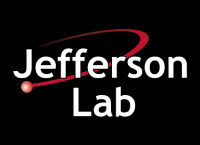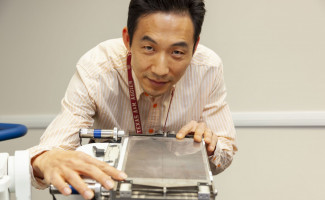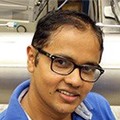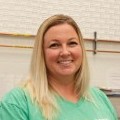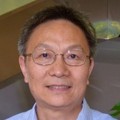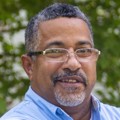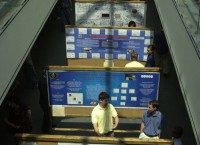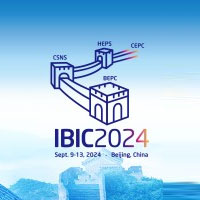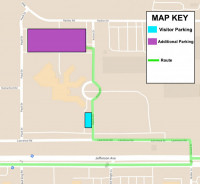Seungjoon Lee contributes groundbreaking invention to life-saving breast imaging technology
From his second-floor office in the Advanced Research Center (ARC) building at Jefferson Lab, Detector Scientist Seungjoon Lee is making the final tweaks to a patented technology that enables 3D nuclear medicine imaging of the breast. Once the machine utilizing the technology is installed in hospitals and medical clinics, it may be used by millions of patients and could help save thousands of lives.
The new technology is called the Variable Angle Slant Hole collimator, or VASH collimator.
“It will be a milestone in the lab,” says Lee.
The technology has already been licensed to Newport News-based Dilon Technologies, which has offices for ten to fifteen employees located just upstairs from Jefferson Lab’s Radiation and Detector Imaging group, to which Lee belongs.
Detector Group’s Role in Breast Cancer Detection
To understand the importance of Lee’s invention, it is critical to be aware of the existing breast cancer detection technologies widely used on the market. The current standard for breast cancer screening is the mammogram.
“A mammogram is an X-ray image of the breast,” explains Lee. “To get a good X-ray image the breast needs to be tightly compressed.”
Yet, for women with dense breast tissue, a mammogram may not provide accurate enough images. For that reason, the group’s gamma imaging technology was widely celebrated and adopted around the world. According to Lee, gamma imaging can provide a clearer image of cancerous masses within the breast, particularly in women with dense breasts. To take an image via the gamma camera, a patient is first given a radioactive chemical intravenously.
“The chemical binds to cancer cells and a few of minutes later, you image the breast,” explains Lee. “If there is a cancer, it lights up in the detector. That’s molecular imaging.”
While gamma imaging can provide another imaging tool for doctors, the chemical injected into the patient does emit radiation.
“People are worried about the dose of the chemical that is injected into the patient, because that’s radiation inside the body,” explains Lee. “A mammogram also subjects patients to radiation in the form of X-rays, but it’s lower exposure.”
Adding the new VASH collimator to a gamma imaging system will allow for a much smaller amount of radioactive chemical to be given to patients. Once the complete system is on the market, it’s expected to have a similar safety level as a mammogram. Plus, it provides a 3D view of the breast, providing a better, more accurate image of potential cancers.
Solving a Rotating Problem
To create 3D images of the breast with the VASH collimator, Lee had to combine his background as a mechanical engineer with his post-graduate and post-doctorate experience in biomedical optics.
“For the common CT or SPECT scans, a detector rotates around the patient, which is why these devices look like a cylinder,” explains Lee. “For breast imaging, it’s hard to rotate around the breast because there’s limited space. Also, the breast needs to be under compression. It’s difficult to rotate a device around it while also compressing.”
To solve these issues, Lee began by starting with a standard parallel collimator that is shaped like a honeycomb with square openings. He then designed one able to have the angle of the openings to be variable under computer control.
“The parallel collimator passes gamma rays that travel perpendicular to the detector face. If the honeycomb structure is skewed in one direction or the other, you can change the angle,” says Lee. “Imagine a window screen. If you stack multiple window screens, that makes the collimator structure. If you move the screens a little on the side, the angle of light passing through will be changed. If you stack multiple screens and don’t change the bottom screen, but change the top screen or middle screen, we can get multiple projection images with a stationary detector.”
In order to further reduce radiation exposure to patients and get even better images, Lee is also developing a dual-headed detector that will take one image from below and one from above the breast.
“It’s a game-changer,” confirms Lee.
Maintaining Strong Ties to Korean Community
Lee’s mother may have predicted his success in mechanical engineering when he was a young boy growing up in Seoul, Korea.
“My mom told me I tried to disassemble a telephone at age five,” he laughs. “That’s my blood—pure mechanical engineering.”
So, it came as no surprise when he earned his undergraduate degree in mechanical engineering. Afterwards he moved to the U.S. to attend Texas A&M University, where he earned a master’s degree and went on to earn his Ph.D. in biomedical engineering with a special interest in optics.
Although he has settled in the U.S., Lee hopes to pass on his Korean heritage to his children. He returns to Korea every other year with his wife and two children. At home, the family speaks only Korean, and the children attend Korean school every Saturday, where they learn Korean culture and language.
Through the Korean school, Lee connected with a group of three other tennis partners. The group has been gathering to play every Wednesday for more than 10 years now.
“One player is a medical doctor, one works for NASA, and the other is an engineering professor,” says Lee. “There are a lot of common interests around work topics, and everyone is so busy, we play once a week for four hours.”
Lee’s busy schedule is likely to continue over the next few years as he works to test and refine his VASH technology. If all goes according to plan, he hopes to see the VASH collimator hit the market in approximately two years.
By Carrie Rogers


